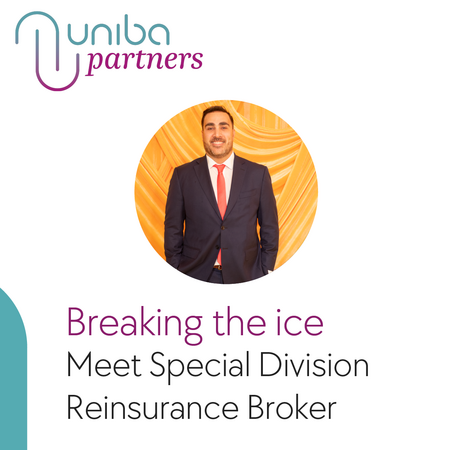UNIBA's Bangkok Blog: The Year of Automation by Andrew McBean (Grant Thornton)
22 September 2023

With UNIBA’s Worldwide Conference in Bangkok, Thailand (25-28 October 2023) at our doorstep, we will spend the upcoming weeks introducing speakers, sponsors and the latest hot topics on ‘The Changing Face of Risk’. In this edition Andrew McBean, Partner at Grant Thornton, will be introducing his upcoming Conference topic ‘Leveraging Technology - From Business Processes to Generative AI: where should brokers be investing’.
With pandemic-related work disruptions now mostly in the rear view mirror, businesses at last have a relatively clear view of what the coming months and years will bring. This clarity lets everyone — from investors and R&D teams to marketers and HR managers — chart a course forward for the post-COVID era.
But every silver lining has a cloud. Covid dramatically accelerated trends, issues and opportunities that were already bubbling under the surface before it hit. In the present case, the view that emerges is not of a smooth and straight road ahead, but rather a rough chicaning racetrack littered with obstacles and nimble competitors.
Up to this moment, businesses seeking a recovery from the COVID-induced recession have generally put longer-term projects on hold in order to focus their efforts on mitigating these challenges as they arise.
Indeed, each of the aforementioned issues appears to merit its own unique response. The push towards working from home naturally prompted companies to develop relevant adaptations within their corporate cultures and HR policies. The Great Resignation forced recruitment managers to consider values more carefully when matching new talent with potential employers. High inflation rates caused companies to recalculate their financial projections — and on down the line.
On an issue-by-issue level, these responses seem perfectly sensible. Yet by early 2023, companies across industries have increasingly turned to an alternative strategy which neatly addresses these and many other business challenges in one fell swoop.
Ironically, many organisations had already laid the groundwork for robotic process automation (RPA) before the pandemic hit, but allowed themselves to be sidetracked by the appearance of one sudden problem after another. Rather than staying the course and letting RPA deliver the benefits it had promised, business leaders found themselves instead playing whack-a-mole with each new financial squeeze, talent crisis, and market shift as it appeared.
RPA alone cannot solve these and other common business problems — but it does make them far more manageable. RPA also frees up more of your personnel to work creatively, thereby accelerating the pace of innovation and adaptation within your organisation. This ideation advantage will be of particular importance when dealing with problems that haven’t even appeared yet, as the unpredictable future unfolds.
Below, we will explain what RPA involves and how it works, before we dive deeper into the topic during UNIBA’s Worldwide Conference.

Never send a human to do a machine’s job
As the economy evolves and companies become more specialised, growing numbers of businesses are learning to focus on their core operations and automate (or outsource) everything else. Robotic process automation is simply the automated half of this equation, with tailored software performing the kind of predictable tasks that human operators tend to find monotonous and uninspiring.
The standard application of RPA algorithms begins with a computer programme that simply monitors the digital behaviour of the human operator whom it will ultimately support or replace. The programme quickly learns which actions are needed to complete a variety of tasks, such as how to scan and process invoices, reply to customer queries, analyse the performance of internal systems, or complete a host of other well-defined procedures. The software can then reliably carry out the same steps whenever the need arises, thereby cutting humans out of the loop.
The capability and versatility of RPA programmes often comes as a surprise to business leaders who have yet to see them in action. These strengths can then be multiplied further when integrated across systems, or paired with other forms of AI and machine learning.
RPA is highly effective at improving operational efficiency, and it should come as no surprise that computers can perform repetitive tasks more quickly than people (while also working 24 hours a day without complaint). But other benefits of RPA are often overlooked — even by organisations that have already adopted the technology.
For example, RPA can also analyse entire processes, in addition to merely performing them. These analyses can detect opportunities for process optimisation, by combining tasks, removing redundancies, and cutting out other kinds of unnecessary steps.
Consider a company that has recently completed a merger or acquisition. Very likely the new entity finds itself burdened with overlapping processes which can be difficult to integrate and cumbersome to maintain. A properly implemented RPA system can simplify and optimise the relevant procedures so that the inefficiencies are removed — and then partially or entirely automate the new process itself. These abilities can dramatically hasten the integration of otherwise incompatible processes, letting the newly merged organisation hit the ground running.
With so many practical use cases already available, it’s no wonder that the RPA space is on track for major growth. An International Data Corporation survey estimates that RPA software revenue will rise from US$561 million in 2021 to US$2.6 billion in 2026, for a compound annual growth rate of 36%.
Taking the first step
Automation is a key pillar of digital transformation, alongside artificial intelligence and machine learning. Together with a modern leadership structure and a culture of innovation, these ingredients, when properly mixed, are the recipe for success in all industries moving forward.
Robotic process automation also happens to meaningfully address the precise set of challenges that many businesses now face in a post-COVID era. From cost and efficiency issues, to skills shortages and employee demands to work from home, to customer expectations of prompt online service, RPA clears an impressive set of obstacles that may otherwise block the path toward growth.
Moreover, the RPA transformation journey goes beyond solving existing problems; it also creates new opportunities for business. By eliminating many repetitive tasks, RPA frees up your workers to use their industry knowledge and expertise for creative ends. Indeed, by integrating automation successfully into existing processes, complete shifts in business models are enabled.
Keep in mind, however, that implementing automation requires more than just a simple ‘drag and drop’ approach. Full-scale, enterprise-wide collaboration is needed across all departments to achieve success. An area that clients typically struggle with is discovering which of their processes are particularly well suited to automation. Part of this challenge is a lack of understanding in the business about automation, and another part is that comprehensive analysis is often hard to achieve from the inside.
Andrew McBean will be speaking on Day 2 of UNIBA Partner’s Worldwide Conference in Bangkok, Thailand (25-28 October 2023). For more details please visit the microsite and event page (Partners only).


